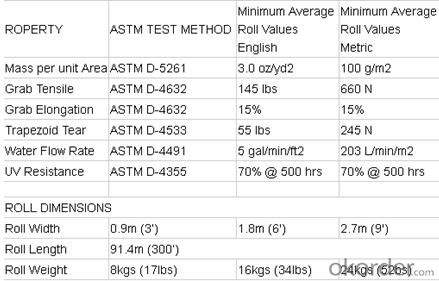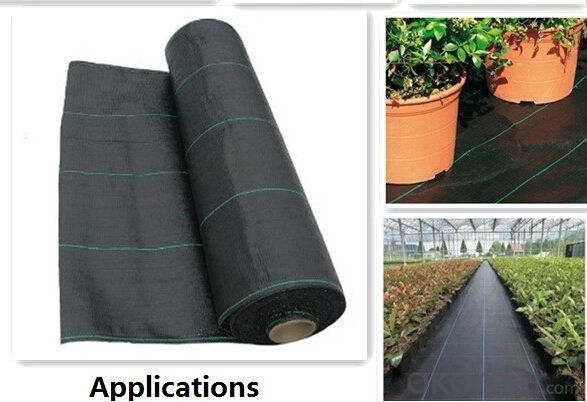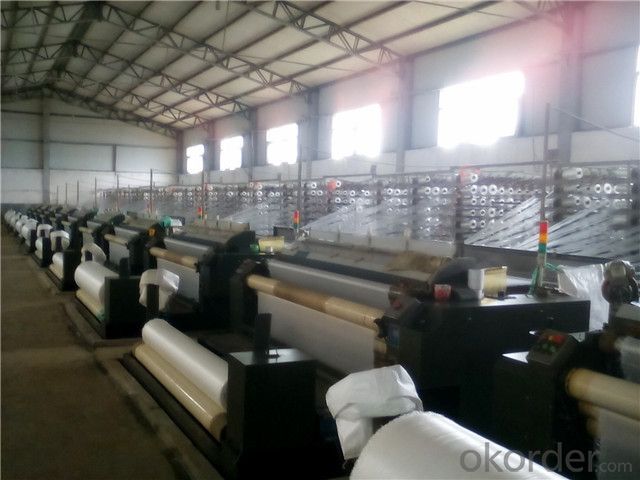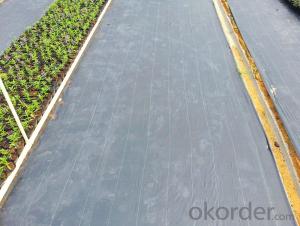Anti Weed Barrier Fabric/Mat Woven Geotextile
- Loading Port:
- China main port
- Payment Terms:
- TT or LC
- Min Order Qty:
- 1000 m²
- Supply Capability:
- 10000 m²/month
OKorder Service Pledge
OKorder Financial Service
You Might Also Like
1. Anti Weed Barrier Fabric Description:
Anti Weed Barrier Fabric is made of environmentally friendly raw materials, pp woven fabric. It used to prevent the growth of weed,
without the use of potentially dangerous chemical sprays or labor intensive hoeing. They are permeable fabrics, which allow air, water and nutrients to pass through, and designed to block out the sun to reduce
photosynthesis and stop weed growth.

2. Anti Weed Barrier Fabric Specification:

3. Anti Weed Barrier Fabric Functions and Features:
1)Excellent weed control
2)Excellent UV resistance
3)Moisture,fertilizers,air reach plants to allow for healthy soil
4)Good water and air permeability
5)Exceptional toughness and strength
6)Durable,tear-resistant,anti-rot and anti-mildew
7)Light weight,easy to install,follows natural ground contours
8)Ideal for use in landscaped beds,under decks and walkways
9)Fashionable design,high quality,competitive price
10)Long service life

4. Anti Weed Barrier Fabric Property:
1) Light weight, high strength, low elongation, easy to construct.
2) Reinforcement, separation, drainage and filtration, fencing function, etc.
5. Anti Weed Barrier Fabric Application:
It can be widely used in areas of railways, highways, sport fields, earthwork, etc.

6. FAQ:
Q1:Can you send samples to us ?
A1:Yes , free samples could be provided , but customer need pay for the freight cost . After order placed , the freight charge could be refund .
Q2:What’s your Payment term ?
A2:T/T , L/C , Western Union,Paypal ...
Q3:What’s your manufacture process time ?
A3:Usually within 20 days
- Q:What are the factors to consider when designing geotextile tubes for dewatering?
- When designing geotextile tubes for dewatering, there are several factors to consider. Firstly, the type and characteristics of the sediment or sludge being dewatered should be evaluated, including its composition, particle size distribution, and consolidation properties. This information will help determine the appropriate geotextile fabric and pore size required to effectively retain the solids while allowing water to drain. Secondly, the hydraulic loading conditions need to be considered. The flow rate, pressure, and duration of the dewatering process will influence the required strength and permeability of the geotextile tubes. Adequate strength is crucial to withstand the hydraulic forces and prevent structural failure. Additionally, the site conditions and environmental factors should be taken into account. The stability of the ground where the geotextile tubes will be placed, as well as any potential erosion or slope stability issues, should be thoroughly analyzed. The project location, climate, and potential impact on surrounding ecosystems should also be considered to ensure the chosen design is sustainable and minimizes any adverse effects. Lastly, the cost-effectiveness and practicality of the design should be evaluated. Factors such as the availability and cost of materials, installation methods, and maintenance requirements should be considered to optimize the overall dewatering process. Overall, designing geotextile tubes for dewatering requires a comprehensive assessment of sediment characteristics, hydraulic loading conditions, site conditions, and cost-effectiveness to ensure a successful and efficient dewatering solution.
- Q:How do geotextiles affect soil permeability?
- Geotextiles can improve or reduce soil permeability depending on the specific application and design. In some cases, geotextiles act as a filter, allowing water to pass through while trapping fine particles and preventing clogging. This can enhance soil permeability by preventing the formation of a dense layer that obstructs water flow. On the other hand, certain geotextiles can be designed to decrease soil permeability by acting as a barrier, preventing water from infiltrating or draining through the soil. Ultimately, the impact of geotextiles on soil permeability is determined by their purpose and the specific properties of the material used.
- Q:How do geotextiles help in preventing sinkhole formation?
- Geotextiles help in preventing sinkhole formation by providing a stable base for the soil and reducing the risk of erosion. They act as a barrier to prevent the movement of soil particles, thus preventing the formation of voids or cavities that can lead to sinkholes. Additionally, geotextiles can improve the overall structural integrity of the soil, enhancing its load-bearing capacity and minimizing the potential for sinkhole development.
- Q:What are the different geotextile installation techniques for erosion control blankets?
- There are several geotextile installation techniques for erosion control blankets, including anchoring, stapling, trenching, and pinning. Anchoring involves using stakes or pins to secure the blanket to the ground. Stapling uses staples or nails to attach the blanket directly to the soil. Trenching involves burying the edges of the blanket in a shallow trench to prevent water from getting underneath. Pinning involves using metal pins or stakes to secure the blanket to the ground. Each technique has its advantages and is chosen based on the specific needs and conditions of the erosion control project.
- Q:Can geotextiles be used in river training works?
- Yes, geotextiles can be used in river training works. They are often used to reinforce riverbanks, control soil erosion, and stabilize the riverbed. Geotextiles can help manage water flow, prevent sedimentation, and improve overall river stability.
- Q:What are the limitations of using geotextiles?
- Some limitations of using geotextiles include their susceptibility to clogging, reduced effectiveness in high-flow conditions, potential for damage during installation or handling, limited ability to withstand heavy loads, and relatively short lifespan compared to other geosynthetic materials. Additionally, geotextiles may not be suitable for all soil types or environmental conditions, and their performance can vary depending on factors such as installation technique and maintenance.
- Q:How do geotextiles affect soil moisture retention?
- Geotextiles can positively impact soil moisture retention by acting as a barrier that prevents excessive evaporation of water from the soil surface. They create a physical barrier that reduces water loss through evaporation, thus helping to retain moisture within the soil. Additionally, geotextiles can also facilitate water infiltration and distribution, promoting better water retention and preventing runoff. Overall, geotextiles play a crucial role in enhancing soil moisture retention and improving water management in various applications, such as agriculture, landscaping, and erosion control.
- Q:What are the factors to consider when selecting geotextiles for a project?
- When selecting geotextiles for a project, there are several factors to consider. Firstly, it is important to assess the specific requirements of the project. This includes considering the expected load and stress that the geotextiles will need to bear, as well as the expected site conditions such as soil type and water flow. Additionally, the durability and longevity of the geotextiles should be considered, taking into account factors such as UV resistance and resistance to chemical degradation. The cost and availability of the geotextiles should also be taken into account, as well as any specific design or regulatory requirements for the project. Lastly, it is crucial to consider the manufacturer's reputation and the geotextiles' performance history through references and testing data. Overall, a comprehensive evaluation of project requirements, performance characteristics, cost, and availability will help in selecting the most suitable geotextiles for a project.
- Q:The properties of woven geotextiles
- Product features: 1, with a reinforcement function: to stabilize the project in the course of prolonged use of the transfer occurred, and can be the role of the soil in the local stress transmission or assigned to a larger area. 2, with the role of separation: woven geotextile with different geotechnical structure to form a stable interface, in accordance with the requirements to play their own characteristics and the overall role. 3, the role of drainage filter: allow moisture to block the loss of sand particles, in the drainage of geotextiles on the poor water in the soil can play the water along the geotextile quickly discharged the purpose. 4, the geotextile and geomembrane used in two different pressures between the material can play a role in tension diaphragm. 5, with a block function: the geotextile placed in the flow of liquid with suspended particles in the channel to organize fine mud particles, and allow the liquid through the function. 6, play the role of cushion mat: the geotextile placed on the slope can prevent the soil particles due to the erosion of rain and the loss or planting turf.
- Q:How do geotextiles help in soil reinforcement?
- Geotextiles help in soil reinforcement by providing a stable and strong layer between the soil and other materials. They distribute the load evenly, preventing soil erosion and enhancing its strength and stability. Geotextiles also allow water to drain through while retaining soil particles, reducing the risk of soil movement or failure.
1. Manufacturer Overview |
|
|---|---|
| Location | |
| Year Established | |
| Annual Output Value | |
| Main Markets | |
| Company Certifications | |
2. Manufacturer Certificates |
|
|---|---|
| a) Certification Name | |
| Range | |
| Reference | |
| Validity Period | |
3. Manufacturer Capability |
|
|---|---|
| a)Trade Capacity | |
| Nearest Port | |
| Export Percentage | |
| No.of Employees in Trade Department | |
| Language Spoken: | |
| b)Factory Information | |
| Factory Size: | |
| No. of Production Lines | |
| Contract Manufacturing | |
| Product Price Range | |
Send your message to us
Anti Weed Barrier Fabric/Mat Woven Geotextile
- Loading Port:
- China main port
- Payment Terms:
- TT or LC
- Min Order Qty:
- 1000 m²
- Supply Capability:
- 10000 m²/month
OKorder Service Pledge
OKorder Financial Service
Similar products
New products
Hot products
Hot Searches
Related keywords


































